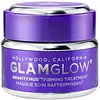What's inside
What's inside
 Key Ingredients
Key Ingredients

 Benefits
Benefits

 Concerns
Concerns

 Ingredients Side-by-side
Ingredients Side-by-side

Water
Skin ConditioningPolyvinyl Alcohol
Alcohol Denat.
AntimicrobialButylene Glycol
HumectantGlycerin
HumectantEthylhexyl Hydroxystearate
EmollientHamamelis Virginiana Water
AstringentMontmorillonite
AbsorbentPentylene Glycol
Skin ConditioningIllite
AbrasivePolysorbate 20
EmulsifyingCanadian Colloidal Clay
Skin ConditioningCaprylyl Glycol
EmollientAlthaea Officinalis Leaf Extract
Skin ConditioningTapioca Starch
Chondrus Crispus
MaskingColloidal Platinum
AntimicrobialDipotassium Glycyrrhizate
HumectantAlcohol
AntimicrobialAscophyllum Nodosum Powder
Skin ConditioningPolysorbate 80
EmulsifyingPolymethylsilsesquioxane
Hydroxypropyl Methylcellulose
Emulsion StabilisingCitric Acid
BufferingLecithin
EmollientPullulan
Porphyridium Cruentum Extract
Skin ConditioningSoy Isoflavones
Skin ConditioningSodium Hyaluronate
HumectantXanthan Gum
EmulsifyingParfum
MaskingCoumarin
PerfumingDisodium EDTA
Phenoxyethanol
PreservativeSorbic Acid
PreservativePotassium Sorbate
PreservativeCI 77163
Cosmetic ColorantWater, Polyvinyl Alcohol, Alcohol Denat., Butylene Glycol, Glycerin, Ethylhexyl Hydroxystearate, Hamamelis Virginiana Water, Montmorillonite, Pentylene Glycol, Illite, Polysorbate 20, Canadian Colloidal Clay, Caprylyl Glycol, Althaea Officinalis Leaf Extract, Tapioca Starch, Chondrus Crispus, Colloidal Platinum, Dipotassium Glycyrrhizate, Alcohol, Ascophyllum Nodosum Powder, Polysorbate 80, Polymethylsilsesquioxane, Hydroxypropyl Methylcellulose, Citric Acid, Lecithin, Pullulan, Porphyridium Cruentum Extract, Soy Isoflavones, Sodium Hyaluronate, Xanthan Gum, Parfum, Coumarin, Disodium EDTA, Phenoxyethanol, Sorbic Acid, Potassium Sorbate, CI 77163
Water
Skin ConditioningCocamidopropyl Hydroxysultaine
CleansingGlycolic Acid
BufferingGlycerin
HumectantPEG-6 Cocamide
EmulsifyingPolyacrylate Crosspolymer-6
Emulsion StabilisingDisodium Cocoyl Glutamate
CleansingHydroxyacetophenone
AntioxidantSuccinoglycan
Skin ConditioningSimmondsia Chinensis Seed Oil
EmollientCalendula Officinalis Flower Extract
MaskingCitrus Aurantium Dulcis Peel Oil
MaskingCitrus Paradisi Peel Oil
MaskingLeuconostoc/Radish Root Ferment Filtrate
AntimicrobialUrea
BufferingAllantoin
Skin ConditioningPolyquaternium-51
Skin ConditioningTrehalose
HumectantCaprylyl Glycol
EmollientSodium Hyaluronate
HumectantTocopherol
AntioxidantHydrogenated Palm Glycerides Citrate
EmollientGlyceryl Oleate
EmollientCoconut Acid
Cleansing1,2-Hexanediol
Skin ConditioningT-Butyl Alcohol
PerfumingCoco-Glucoside
CleansingSodium PCA
HumectantSodium Chloride
MaskingSodium Hydroxide
BufferingCitric Acid
BufferingPotassium Sorbate
PreservativeSodium Benzoate
MaskingLimonene
PerfumingWater, Cocamidopropyl Hydroxysultaine, Glycolic Acid, Glycerin, PEG-6 Cocamide, Polyacrylate Crosspolymer-6, Disodium Cocoyl Glutamate, Hydroxyacetophenone, Succinoglycan, Simmondsia Chinensis Seed Oil, Calendula Officinalis Flower Extract, Citrus Aurantium Dulcis Peel Oil, Citrus Paradisi Peel Oil, Leuconostoc/Radish Root Ferment Filtrate, Urea, Allantoin, Polyquaternium-51, Trehalose, Caprylyl Glycol, Sodium Hyaluronate, Tocopherol, Hydrogenated Palm Glycerides Citrate, Glyceryl Oleate, Coconut Acid, 1,2-Hexanediol, T-Butyl Alcohol, Coco-Glucoside, Sodium PCA, Sodium Chloride, Sodium Hydroxide, Citric Acid, Potassium Sorbate, Sodium Benzoate, Limonene
 Reviews
Reviews

Ingredients Explained
These ingredients are found in both products.
Ingredients higher up in an ingredient list are typically present in a larger amount.
Caprylyl Glycol is a humectant and emollient, meaning it attracts and preserves moisture.
It is a common ingredient in many products, especially those designed to hydrate skin. The primary benefits are retaining moisture, skin softening, and promoting a healthy skin barrier.
Though Caprylyl Glycol is an alcohol derived from fatty acids, it is not the kind that can dry out skin.
This ingredient is also used as a preservative to extend the life of products. It has slight antimicrobial properties.
Learn more about Caprylyl GlycolCitric Acid is an alpha hydroxy acid (AHA) naturally found in citrus fruits like oranges, lemons, and limes.
Like other AHAs, citric acid can exfoliate skin by breaking down the bonds that hold dead skin cells together. This helps reveal smoother and brighter skin underneath.
However, this exfoliating effect only happens at high concentrations (20%) which can be hard to find in cosmetic products.
Due to this, citric acid is usually included in small amounts as a pH adjuster. This helps keep products slightly more acidic and compatible with skin's natural pH.
In skincare formulas, citric acid can:
While it can provide some skin benefits, research shows lactic acid and glycolic acid are generally more effective and less irritating exfoliants.
Most citric acid used in skincare today is made by fermenting sugars (usually from molasses). This synthetic version is identical to the natural citrus form but easier to stabilize and use in formulations.
Read more about some other popular AHA's here:
Learn more about Citric AcidGlycerin is already naturally found in your skin. It helps moisturize and protect your skin.
A study from 2016 found glycerin to be more effective as a humectant than AHAs and hyaluronic acid.
As a humectant, it helps the skin stay hydrated by pulling moisture to your skin. The low molecular weight of glycerin allows it to pull moisture into the deeper layers of your skin.
Hydrated skin improves your skin barrier; Your skin barrier helps protect against irritants and bacteria.
Glycerin has also been found to have antimicrobial and antiviral properties. Due to these properties, glycerin is often used in wound and burn treatments.
In cosmetics, glycerin is usually derived from plants such as soybean or palm. However, it can also be sourced from animals, such as tallow or animal fat.
This ingredient is organic, colorless, odorless, and non-toxic.
Glycerin is the name for this ingredient in American English. British English uses Glycerol/Glycerine.
Learn more about GlycerinPotassium Sorbate is a preservative used to prevent yeast and mold in products. It is commonly found in both cosmetic and food products.
This ingredient comes from potassium salt derived from sorbic acid. Sorbic acid is a natural antibiotic and effective against fungus.
Both potassium sorbate and sorbic acid can be found in baked goods, cheeses, dried meats, dried fruit, ice cream, pickles, wine, yogurt, and more.
You'll often find this ingredient used with other preservatives.
Learn more about Potassium SorbateSodium Hyaluronate is hyaluronic acid's salt form. It is commonly derived from the sodium salt of hyaluronic acid.
Like hyaluronic acid, it is great at holding water and acts as a humectant. This makes it a great skin hydrating ingredient.
Sodium Hyaluronate is naturally occurring in our bodies and is mostly found in eye fluid and joints.
These are some other common types of Hyaluronic Acid:
Learn more about Sodium HyaluronateWater. It's the most common cosmetic ingredient of all. You'll usually see it at the top of ingredient lists, meaning that it makes up the largest part of the product.
So why is it so popular? Water most often acts as a solvent - this means that it helps dissolve other ingredients into the formulation.
You'll also recognize water as that liquid we all need to stay alive. If you see this, drink a glass of water. Stay hydrated!
Learn more about Water